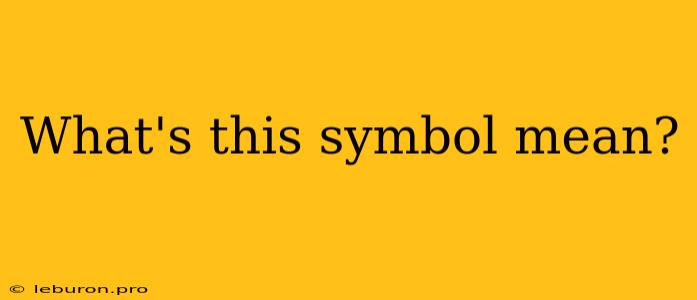In the vast and intricate world of symbols, understanding their meanings can be a captivating journey. Symbols have been employed throughout history by various cultures to convey complex ideas, emotions, and beliefs. From ancient hieroglyphics to modern emojis, symbols serve as powerful tools of communication. However, encountering an unfamiliar symbol can leave us bewildered, questioning its significance. This article delves into the fascinating realm of symbols, exploring how to decipher their meanings and appreciate the richness they bring to our lives.
The Power of Symbols
Symbols hold a profound power to transcend language barriers and connect people across cultures. They have the ability to evoke emotions, inspire action, and shape our understanding of the world. A symbol's meaning can be both personal and universal, depending on context and individual interpretation.
Understanding Symbolism
To unravel the meaning of a symbol, it's essential to consider its historical, cultural, and social context. Each symbol carries layers of meaning that have evolved over time. For instance, the cross, a symbol of Christianity, has deep roots in ancient civilizations where it represented the four cardinal directions. Similarly, the yin-yang symbol, originating in ancient China, embodies the duality of opposites, such as light and darkness, male and female.
Different Types of Symbols
Symbols can be categorized into various types, each with its unique characteristics and significance:
- Cultural Symbols: These symbols are specific to a particular culture or society, reflecting their beliefs, values, and traditions. For example, the Star of David is a cultural symbol of Judaism, while the crescent moon is a symbol of Islam.
- Religious Symbols: Religious symbols hold profound meaning for followers of a specific faith, representing deities, beliefs, or sacred objects. The crucifix is a prominent symbol in Christianity, while the Om symbol is revered in Hinduism.
- National Symbols: National symbols represent a country's identity, heritage, and values. The American flag, with its stripes and stars, symbolizes freedom and unity. Similarly, the maple leaf is a national symbol of Canada.
- Political Symbols: Political symbols often represent ideologies, movements, or political parties. The hammer and sickle, for example, symbolize communism, while the elephant and donkey are symbols of the Republican and Democratic parties in the United States.
Deciphering Symbol Meanings
There are several approaches to understanding the meaning of a symbol:
- Context: Examining the context in which the symbol appears can provide valuable clues. For example, a symbol might have a different meaning in a religious setting than in a political context.
- Research: Exploring historical and cultural sources can shed light on the origins and evolution of a symbol. Libraries, museums, and online resources can be valuable sources of information.
- Interpretation: Symbols can evoke different meanings for different individuals. It's essential to consider your own personal experiences, beliefs, and perspectives when interpreting a symbol's meaning.
The Importance of Symbols in Modern Life
Symbols continue to play a vital role in our modern lives, shaping our perceptions, beliefs, and interactions. From logos and branding to emojis and social media icons, symbols are pervasive in contemporary culture.
Symbols in Branding and Marketing
Companies utilize symbols to create a unique brand identity and resonate with their target audiences. A strong brand symbol can evoke positive associations, create brand loyalty, and differentiate a company from competitors.
Symbols in Social Media
Emojis and other digital symbols have become integral to online communication. They allow us to express emotions, convey tone, and add humor to our messages. These symbols have bridged cultural gaps and facilitated global communication.
Symbols in Art and Literature
Throughout history, artists and writers have employed symbols to convey complex ideas, emotions, and themes. Symbols in art and literature can evoke powerful imagery, create suspense, and deepen the meaning of a work.
Conclusion
Understanding the meaning of symbols is crucial for navigating the complexities of our world. From ancient civilizations to modern digital platforms, symbols have the power to shape our perceptions, beliefs, and interactions. By exploring the historical, cultural, and social context of a symbol, we can uncover its rich layers of meaning and appreciate the power it holds to connect us across time and space.
